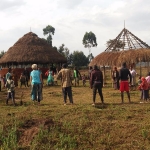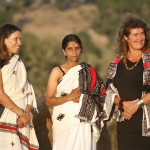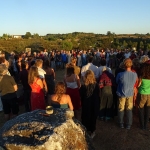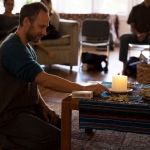by Johannes Ewig (with a foreword by Dara Silverman)
Foreword (by Dara Silverman August 2017)
The movement that arose at Standing Rock against the Dakota Access Pipeline awakened and inspired activists around the world, marking a new dawn of activism. Tribal knowledge embedded in a depth of spiritual connection was experienced by a group of people driven by a high common aim – despite the long oppression they have suffered.
Coming to Tamera as an activist, I knew that this form of fighting the system was nearly a lost cause. I knew through standing on the frontlines, eventually hitting burnout, which would last until the next demonstration, these struggles ultimately would not create the shift my fellow activists and I wished for. I discovered that reforms, changes in government leadership or radicalizing power structures alone would never be enough. Despite the good results these actions can achieve, despite the feeling of being part of something greater that the activist feels in the height and hype of their movement, when the police inevitably come in and tear it down, when the internal power games of the activists become stronger than the vision, when you ultimately go back to your apartment at the end of the day, you are left heavy- hearted again, facing a system you can never measure up to.
Without knowing how to create sustainable community, this sensation the activist feels in demonstrations remains a dream.
Without being consciously aware of how the external political situations and the internal movement of the human being are interlinked, I strongly question if sustainable change is possible. And if it’s not, I doubt if humanity will make it.
I do now know, however, that if we collectively wake up, we will encounter a power greater than all violence. We will succeed when we are connected with the power of community and anchored in the greater community of universal spirit. This is what the movement at Standing Rock showed the world. The stance they took under the motto “Defend the Sacred” touched a deep layer of the human heart. This was a movement that didn’t only say NO to the system, but stood for the YES of protecting life, the earth body and all her creatures.
What began in Standing Rock in 2016 must turn into a planetary movement in 2017 – engaging the wisdom of community and bridging it with futurological knowledge for a regenerative life that includes all beings on this planet.
Johannes’ article exemplifies what this decision for life means and how establishing lasting community is lost knowledge that we have the opportunity to study for the future of humanity.
Key Insights for Lasting Community
By Johannes Ewig February 2016
Introduction: Evolutionary Steps of Human Culture
When James Watts invented the steam engine over 200 years ago, there was most likely no human being whose visionary horizon was broad enough to foresee the cultural revolution this machine would bring about. What Watts developed was more than simply a new machine. In his mind, his lab and the concrete manifestation of this idea, he set the foundations for a global cultural development which changed the face of the world forever. The steam engine was the start of the industrial age and so the first step toward globalization. Watts’ invention marked a quantum leap in possibilities; step by step an entirely new horizon opened to humanity. Methods of hard, time- consuming manual labor gave way to limitless and speedy possibilities of production. An old perspective and its potential for interaction with the world was changed at the roots. Watts captured the zeitgeist, a moment that determined the evolution of humanity. The same is true for Rockefeller’s development and use of oil sources 100 years later (marking the start of the oil industry) or Norbert Wiener’s invention of the binary system at the conclusion of the Second World War (the basis for digital processing). All of these inventions shaped society in new ways through technological progress. All carried within them a seed of innovation, which offered a new worldview to the human mind. And all marked the start of a global cultural development toward the world in which we live today.
When we look at this series of inventions, we realize all of them were technological advancements. Why is this kind of evolution restricted to the technological realm? Over the course of the last millennia why weren’t there similar impulses on a social level, which shaped the spiritual or sexual being of humanity in a similar way?
Couldn’t this sort of technological progress be translated to other areas of our social life? What would happen if an impulse of similar dimensions ran through the social, spiritual or erotic realms of humanity?
Building communities of trust is an impulse of this kind. In this essay, I want to show that cultural innovation is also possible in the interior life of humans. This does not mean using social science to form new organizational or governance structures. Rather, it means building social forms and structures that foster our ability of reflection, self- knowledge, insight, trust, solidarity and love. The appeal to the individual has historically failed and no revolutionary heart, however strong it may be (as with Mahatma Gandhi or Martin Luther King Jr.), can overcome the collective structure of isolation or fear in the long run. In communities of trust, there is a potential for growth on par with the technological advances of the last century, and this sprout of life could provoke a structural shift in the innermost essence of our being. In order to face the apocalyptic crises of our times, and to carry out the revolution that is demanded of us, we need to expand our mind to the question how to build community effectively. In the following, I will speak about the basic principles of community-building and about how communities can endure. To understand the matter we are working on, I will dive both into the history of community and the psychological processes of human life in community. Whenever I write from a “we” perspective, I mean the “we” of those actively working on community. I feel included in this, as I speak from my experience in the Tamera community.
An Organ in the Organism of Humanity
It is important to understand community as more than a longing, an exciting adventure or a relaxed hippy life. I want to bring the essential nature of community into view so that we can understand community- building in an appropriate context. For the majority of human history, community was the primary form of life. Our sense of belonging to a tribe was our existential basis. Home, security, learning, ethical orientation and perspectives about the future were all anchored here. It would have been impossible for our ancestors to imagine living outside of the group they were born into; now, on the contrary, we can hardly imagine being born into and staying with a group for life. Take a moment to consider this: lifelong belonging to a group as a basic condition of life! Community and tribe would be at the center of life, not the family, and certainly not the individual. The family would be an important part of the community as it would gain its embedment and protection and, if needed, reorientation and correction from this larger context. The same is true for the individual: see the upcoming sub- chapter: “The Individual and Community.”
Community is not only a form of organization; it is in itself an organ of life. In building community, we approach a universal principle. All of life in its different stages of development is organized through community. Looking into an intact ecological biotope, a miraculous world of precise cycles and finely attuned symbiosis unfolds before our eyes; we bear witness to a power that lies in the whole system but that none of the individual beings could have brought forth alone. The same is true for human community. The power that people can accumulate within themselves and pass on is multiplied through community. It is as if we actually create more surface for the inspiration and spirit that wants to stream through us. A community of trust is an enlargement of our perceptive faculties and provides us with an abundance of possibilities that are not available to us as mere individuals.
Community as an Inner State of Consciousness
Community is not in the first place a form of life, but a state of consciousness. Community is a spiritual attitude and, ultimately, a basic stance toward life. Once an individual truly grasps the meaning of community, when our love and insight processes are informed by it, then we carry community as a latent reality within us. We become activists and can help to create community wherever we are. Spirit awakens to a higher level of reality which couldn’t be perceived previously. It is the consciousness of a higher level of order that connects life in each moment.
We are never separated individuals and in each moment we are surrounded by an almost overwhelming diversity of conscious life that is breathing, buzzing and crawling. We can always connect to this fact and use it as a source of guidance; this is true for each moment and situation in life we encounter. When we connect with this reality, something in us spontaneously sends impulses through our minds and hearts, which immediately serves to create more trust, more joy and more unity. I myself have often experienced this situation and the joy that comes with it.
What does this mean? What is it that we become more perceptive of? It is the presence of the higher task and unity of a group. It is the growing awareness of the erotic and friendship threads among its participants. It is the intuition for common directions, aims and questions we carry in our lives. It is the ability and joy to use one’s own power for the good of all and no longer simply for oneself. It is the readiness to give voice to all that is unspoken in a group and thereby redirect it toward trust. It is the willingness to accept natural authority, which comes with life experience. Once these perceptions start to set in and become so important to us that we let our actions be guided by them, we become part of a community-building process. We have found orientation in something that is greater than ourselves.
Political Activism and Building Community
Building community today is a question of our political power and efficiency. Co-founder of the Tamera community, Dieter Duhm, made a simple yet profound discovery in his time as a political activist in the 1960s and 70s: the problem of a police blockade was easier to overcome than the question of communal dishwashing – political aims are easier to pursue than to master living among people. What drains groups and eventually leads to their collapse is not the outer, but the inner pressure created when people live together with all their unresolved wishes, fears, longings and projections. We lack the trust, courage, natural authority and clarity to show the density of our internal world. Duhm’s political work consequently focused on shedding light on all aspects of the human being. He writes:
“I was a scientist and writer, but I needed experiential research training and this training has continued ever since. I have been spared nothing that happens among human beings. If one wants to know how humankind functions, one should learn how a group functions, for a group contains all the light and shadow sides of our human existence within it.” (Duhm, Terra Nova, pg. 14)
In order to be politically effective today, we cannot exclude the human being from our political work. Too much of our will and our power is bound up in the fear we have in front of each other, in the corners of our souls in which we hide our love for each other. Communities that want to endure have to be aware of the political dimension of human work so they can navigate through the deeper processes they will inevitably face. New concepts of ecology, economy or technology alone will not be enough to change our world if human beings stay as they are today. We are called to lead ourselves back to the source of our human, erotic, sexual and spiritual longings. This path to the source needs to be incorporated in our political activity.
The Wound of Community
When building community, we don’t start with a clean slate. We don’t have a free heart with which we can simply follow this longing without being reminded of pain. The human being has been deeply wounded at this primal point of community, way beyond the experiences of our current biographies.
Around 7000 years ago, emerging patriarchal rulers began to use “divide and rule” tactics, targeting community, spirituality and sexuality, in order to break people’s authentic inner strength. Because a human being that lives in trust in an autonomous community does not have any reason to obey an outer force, the rising rulers of the imperialist and patriarchal era had to destroy the core of the human being in order to make subjects of them. Through the expulsion of people from their tribes, through murder, rape and the destruction of sacred sites over the course of millennia, we were robbed of an inner source. This source belongs to our psycho-spiritual body as much as the heart belongs to our physical body. I think that our removal from our natural eco and social systems has changed human life more than anything else in history. And today, by arriving at the root of this loss, we face social and ecological dilemmas. Without the bond of community, our surroundings become a threat and we need to protect ourselves. We lose the inner ethics which spontaneously arise from daily life with people. Our family dynamics became strained as they are now forced to take on functions (e.g. raising children) which were originally rooted in the community. These are just a few examples that make this loss visible. To summarize: the inner point that was home to our original trust, compassion and wisdom was invaded by a feeling of isolation and a basic fear toward everything foreign.
This is the heritage we face today when we try to build lasting communities. We need to understand the state of our soul in relation to this, so that we are not only guided by longing, walking from one traumatic experience to the other. Building community demands a high degree of perseverance and sturdiness in the soul so that we can actually allow love to guide us again.
Trust and Revelation
Where does this path to the source begin? I was once asked in a group gathering, “What do you love when you love?” There were 40 people in the space, most of them my friends; it was my birthday and the situation could have developed into a warm and heartfelt atmosphere in which I told my friends about my deeper longings, my love and my life. It was a possibility for revelation and a chance to create trust. For me however, this question was the trigger of a long inner odyssey. My inner voice intuitively answered, “You don’t really want to go there again?”. The space full of friends shifted into an anonymous judge in front of whom I would certainly not speak a word about this treasure, the most sacred within me, of my ability to love. My inner protection shield rose in a split second. Even though I continued living together with the same people and there was no outer threatening reason for this overreaction of mine, the shock in connection with this question lasted for over two years. Only now I begin to understand that there are friends sitting in front of me with whom I can share and deepen my love; only now I begin to act according to this insight.
To build community, trust among humans needs to be built. The human being is only ready to answer these deeper questions of love once real trust develops toward each other. When we reveal ourselves to each other in these regions of love and longing, a shared love begins to grow in the community – this is the knowledge of something sacred that we all carry within ourselves and which we need to care for and protect in mutual solidarity. When these deeper layers can be integrated into our existence through art, calmness, courage, activism and humor, the community gains authentic power. We see and understand more of each other and have the opportunity to bring our visions to fulfillment.
In his handbook for peace-workers, The Decision, Dieter Duhm writes, “Wherever two or more people come together a possibility for revelation, and therefore fulfillment, exists.” Through my own example I can say that it is a deep and necessary learning to encounter the world as it actually is, not through the lens of fear. Trust is the ground on which community grows; when we stay together we sooner or later feel if this trust is real. We feel whether it enables us to get through two years of inner confusion and fear projections. If it does, we realize the promise that lies behind it. We realize the extent of what is possible with the people we live with.
Issue Number One
What I have shared here through my own example is true for an overwhelming majority of people on this planet: the hottest point of revelation lies in the area of love and erotic attraction. When a group is collapsing from inside out, mostly it is due to unspoken love lines, personal questions of acceptance, sexual longing or hidden competition between men and women. These topics have taken over the steering long before the questions of money, structure and hierarchy arise.
In order to clarify this issue further, I want to describe a few soul movements and relevant questions which I’ve gotten to know over time. Love and sexuality are the deepest forces within the human being. We carry them within as sources of inspiration and creation, sources of curiosity and joy. They influence our life decisions and our biographies more than anything else – for better or worse. But what is the essence of love? Where does love want to lead the human being? What is this longing that doesn’t decrease until it is understood? Love is an expanding power. When it is experienced with one person, it wants to continue gifting itself. The human being wants to open up in love. Sometimes we are surprised by the vitality, clarity and life joy of those who’ve just fallen in love. A similar thing is true for Eros. Our sexual and sensual joy with each other grows when Eros can follow its natural movement. Eros is an anarchistic power which leads us at the right pace from one experience to the next if only we let it do so. Isn’t there a secret of attraction in erotic tension and curiosity which, when looking at an entire life span, could lead us much further than to only one partner?
To build healthy and vital communities, these core powers need acceptance. If they are forced into restrictive moralistic ideas, something within the human being begins to rot. An attempt at creating community which ignores these issues and instead only focuses on, for example, an economic approach, will fail. It is not, however, the first priority to vigorously dissolve our ideas of morality. For some, this is the path and, once you give yourself to research in this area, many morals which seemed irreversible disappear. (I myself was happy to be able to fully explore my erotic being while finding my way into the community.) But either way, communities must not overlook these powers and longings within the human being. The existence of love and Eros has to be seen and accepted and needs to have a conscious place within each community, so that our life energies can flow naturally. Both sexual freedom and intimate monogamous love toward one partner have to be allowed. These are fundamental thoughts that a community must understand before they are able to offer any answers to the countless seekers in our world
Character Work: Overcoming the Authoritarian Character
Life in community is probably the deepest character school that exists. When we want to create trust, we have to start speaking truth with each other. And when we start speaking truth and accept what our friends tell us, we need to be willing and ready to change. This readiness is the heart of any community-building process. We will not create a stable human community with masks and lies; to give up these habits we need to live among people who tell us what they perceive in us. This should not be done in an overly serious manner, as we do not want to blame anyone, but with an impulse of helping each other to gain consciousness about the aspects of ourselves we want to leave behind. In this practice, I’ve often experienced real joy and have seen how real friendships deepen through it. It’s fun to be able to tell each other, “Look there it was again” when we know the other one wants to be reminded in these moments and when I am sure of my solidarity and support toward the other.
A real challenge in this is scapegoating. I want to dive into the psychoanalytic work of Wilhelm Reich and Dieter Duhm to explain the dimension of character work we are addressing when we want to build community with autonomous, authentic people. Dissolving the structure of blame shifting and therefore the authoritarian character is a pivotal point for a group.
Wilhelm Reich, a student of Freud and one of the most famous and controversial psychoanalysts of recent history, describes the authoritarian character as the basic character of today’s human being and the root of an omnipresent and latent readiness for violence. He explains the emergence of the authoritarian character as follows.
The life energy of sensuality and lust, already in the child, searches for means of expression. It is a primal joy in the sensuality of matter that we can observe when children are playing in mud or with food, when they happily place their head between the breasts of their mother, or when, in full curiosity, they explore their own sexual organs or those of others. This drive lies within us, and in a society that opposes sexuality, it is suppressed and prohibited from an early age. The parents, who themselves are repressed and full of unlived life, prohibit the child from doing anything that reminds them of their own longings. In this way, as the parents are synonymous with the child’s existence, a love impulse is prohibited by the people who are the most important source of meaning for the child. No child of two or three- years-old can take a stand for their own sexual needs or longings in opposition to their parents. For a very young child, acting against the parents (who represent the focal point of existence) in a core point such as sexuality is psychologically equivalent to death. Therefore, the conflict between the sexual drives and imposed morals becomes linked in our psyche to a fear of death. The child identifies with the judgment of the parents. They adopt the parents’ guidelines and rules and so start to hate what had before been an original source of joy. Through this process, already in childhood, an existential conflict is created which needs to be suppressed so that the norms of the bourgeois world (the world of the parents!) can be upheld. The drive does not vanish through prohibition; it continues to live in the underground and has to be hidden and suppressed. This uses a major part of our mental capacity. The human being that lives with this existential conflict does not ever want to be reminded of it again, for it is stored in the memory as something entirely unsolvable. This conflict rages within each of us to varying degrees.
If in this situation an external conflict arises, the person who is burdened with this inner dilemma is glad to be able to transfer parts of it onto the external situation. Any trigger is sufficient as it is never really about the outer topic of conflict; rather the inner child, focused on its internal world of hidden drives, searches desperately for a way to release the burden. In this way, on a deep character level, the human being is latently prone to any conflict and is always ready to begin fighting with great vigor. He is happy to avoid the actual topic. In any case, he does not believe that solution is possible because any confrontation with this underlying conflict is still linked to the existential fear of death that arose from the friction between his own drive and the authority of the parents and society.
A community of free, autonomous human beings can only arise once this contradiction between drives and morals is dissolved and therefore no longer passed on to our children. For this, the adult has to accept, trace and, as far as possible, resolve this conflict within themself.
In studying these processes, I have noticed several times within my own history and daily life when an immense wave of anger took hold of me, where all my power and will were focused on one particular enemy, one injustice. And with growing presence, I could perceive that something else, something deeper, had taken hold of me and that the intensity of my anger went way beyond what the situation itself justified.
Character work means no longer allowing this deeper aspect to shadow our daily life conflicts. Character work means becoming aware of our own issues and letting conflicts about facts and situation remain as they actually are. Character work means not reacting negatively to friends who point out our trauma structures, but instead pausing and sensing that their input might be helpful. We cannot form a free society from people with authoritarian character structures. We have to navigate toward a human community free of this deep layer of blame shifting. This work is an important path of learning for communities that want to live together in full potency, following great aims for their entire lives.
The Individual and Community
Another core question posed time and again when forming community is about the balance between the individual and the community. We are afraid to lose our freedom by following a collective which rules us and thereby claims our sense of self and identity. These fears stem from a traumatized historical experience that is totally understandable and partially substantiated. However, if we can free ourselves from our traumatized history, there is no contradiction between the individual and the community. A functioning community is comprised of strong individuals without which it could not function. Furthermore, in a community based on trust, mutual support, and direct feedback in daily contact, the authentic individual core within each human being forms. Finally, the individual is no longer alone. The point within each person which throughout history became lonely and melancholic can recharge itself with real, new experiences; thus, the feeling of loneliness slowly dissolves.
The freedom the human being gains in community is far- reaching. In contrast, the individual freedom of our modern world is highly constricted. We can choose from a few readymade modes of decisions, thoughts and habits of consumption. This amounts to the difference between Pepsi and Coca Cola. In this context, hardly anyone will tell me that my true human potential lies in a totally different, as yet unknown place. But in a community where I receive feedback from my friends in daily life, feedback which directs me toward what they perceive to be my real power, beauty and intelligence, I can stay in contact with the place where my highest potential unfolds. People who live in such communities become more and more authentic because they have decided to follow the direction of truth.
A Big Aim: The Joy of Overcoming our Egos
Along with dispensing with our old readymade ideas of individuality, the human being in community also comes into contact with a higher image of self-realization. Communities gain stability and endurance if their members have found and follow a higher aim. This aim is their security net and anchor for all human conflict. A community which does not have a higher common goal does not survive for long because of the intensely explosive power of conflict.
Over the last six years, I have lived at Tamera with people that I know follow the same, or at least similar, aims as me. Because I know this, I can walk into fields of conflict without much inner struggle. I no longer need to feel deeply disappointed or abandoned by the other when conflict occurs. As an unconventional example, in some of my male friends I have discovered the same love toward women, toward sexuality, toward love itself, as I carry inside me. And I have seen their readiness to find and create new communal forms and spaces of truth for this longing in which it can find fulfillment. Because we know this, our friendships have reached a deeper foundation and become much more resilient. I know that we will stay on the same life track and so I do not hold on to anger about their character flaws. We have dedicated our lives, among other things, to truth in love.
Examples of aims that could hold a community together include the establishment of a school, a sanctuary for animals or a cultural or artistic center that revolves around a certain question. This aim should be something which is rooted deep enough in each participant to enable them to push aside any daily conflicts and continue with the necessary work. The joy that arises from such a process is huge, because, at base, we wish for exactly this: people who have dedicated their lives to work and similar lines of inquiry as we have so that we can accompany each other through the ups and downs of life.
Forming a Communitarian Self
When a few people share such an aim, then one of the miracles of community arises: the forming of a communitarian self. The community is able to do things that the individuals alone could not. In a space of trust among people, an increasing coherence emerges and the innate knowledge of each individual gradually connects with the others. A form of group intelligence and frequency is created which could not have been created by the individuals alone. We do not only find a common point of identification with the others. The spirit of the common endeavor becomes its own entity and gains power. All participants belong to something which outlasts the individuals and at the same time is most intimately connected with the personal will, love and work of each participant. We as human beings today do not any longer know this state of being connected to a common greater identity and therefore, in order to build this communitarian self, the community needs guardians and a growing degree of consciousness within each participant. In Tamera, there are people whose profession is the stewarding of this communitarian consciousness. It is a wonderful research track to start searching for this being – the communitarian self – when visiting a community. In strong communities, one will find it, for it is the source of their power.
Becoming a Global Human Being: Community as a School for Compassion
Community can be a school where we learn how to regain a compassionate state of being in unity with all life; we were born in this state and have lost it due to our traumatic history and the systematic pressure of our capitalistic world. After a few years in community, I have observed how my thinking has changed and how the well-being, overall direction and progress of our project is more and more dear to my heart. I started to be interested in people and to take a stand for their needs, even if they weren’t necessarily my friends. Something in me knew that it would be better for the community body (and therefore also for myself) if this person now received attention, could take a step of courage or reveal something in a community space about his/her life path, etc. My focus had turned away from myself and toward the bigger body of life of which I am part. My compassion was suddenly no longer a matter of personal sympathy, but compassion toward the life path of another person. And compassion does not stop at the borders of the community. This movement continues on and on, until it encompasses the entire world. The organ of compassion grows continuously, leading people to an ever greater global awareness. I am connected with the lives of people on the other side of the planet, and in community I have the chance to approach and become conscious of this connection in real-life training.
Disillusion and a Deeper Layer of Joy
I find it a real joy to live together with people who do not simply project community as the seventh heaven of their fulfillment, but who know what kind of work it is about. Our longings are so informed by a fictional image of fulfillment that many people go through a process of disillusion when they step into community. Over time, they realize that community is a life path and a course of study that demands a basic decision, just as with any other serious profession. When you stay with it, you feel a new joy entering the body, the mind and the heart. Each step of genuine trust created between man and woman, each concrete example of a new reality for our children to grow in and each conflict solved are true milestones that mean a great deal to our historic heart. We are on the way, and probably have a long journey ahead, but we know that we are on the right track.
Working on the Nonviolent Information
The digital center of our time, Silicon Valley, is working very successfully on the digitization of our lives. Incredible amounts of money, human intelligence and visionary powers are being invested there, in order to virtually reproduce and enhance the complexity of human life and our social systems. What is currently happening in the global information centers of our times is a cultural revolution of similar dimensions to the series of technological inventions mentioned in the introduction to this piece. This revolution is conquering our world and will succeed with relatively little effort. However, like with all other big technological inventions in history, the success will leave something untouched deep within the human being. Human beings, their longing and their love will once more be left out of the equation.
One task of communities of trust is therefore the creation of the nonviolent information of human life itself. This information must match the level of global thinking as held by the innovators of Silicon Valley. We could apply the same fascination, effort and perseverance to a totally different area of life: the human being, their love, the overcoming of their fears, the step-by-step fulfillment of their longings and the development of a fundamentally nonviolent form of life in
coexistence with all creatures. Today, Tamera is on the path toward becoming a “Silicon Valley of community-building”. We are still far from our aim, but are in the process of recognizing the dimension of the task. Communities of trust could be the first seed of a great humanitarian development to come.
About the author:
Johannes is a student of Tameras internal leadership education, the “Akron School”, and is part of a next generation of leaders & project- carriers, who are growing into responsibility within the community. He has lived in the community since 2010.
As a team member of The Grace Foundation, his work is dedicated to the re-definition of value, the inquiry of the economic system change of our times and money as a resource for healing work.









Leave A Comment